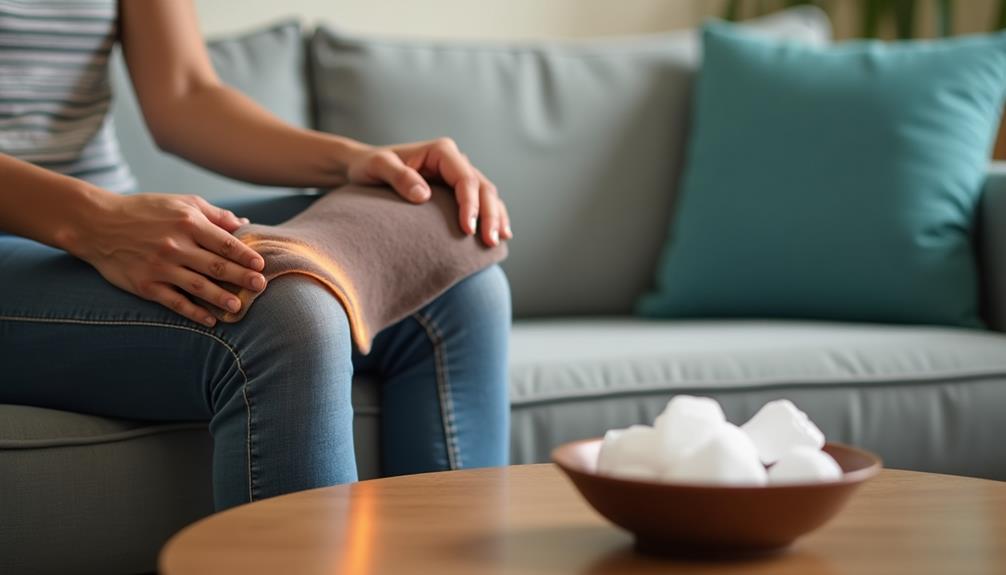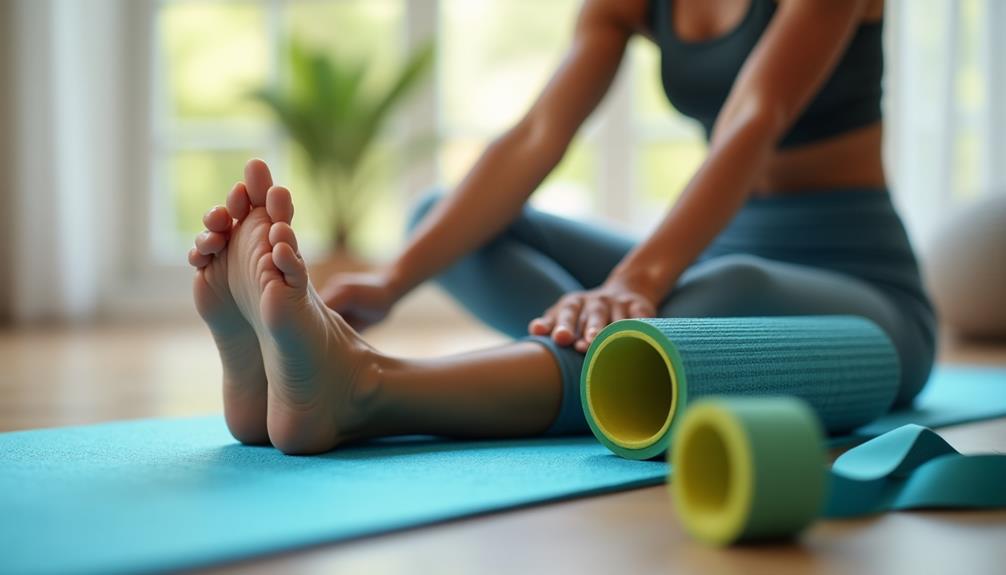To reduce post-leg day soreness, follow these five essential tips. First, hydrate properly by drinking enough water—aim for at least half your body weight in ounces. Second, incorporate stretching, focusing on your quads, hamstrings, calves, and glutes for at least 10-15 minutes post-workout. Third, utilize active recovery; light exercises or yoga can clear metabolic waste. Fourth, apply heat or cold; this can help manage inflammation and pain effectively. Finally, prioritize nutrition with balanced meals rich in carbohydrates and electrolytes. Each of these strategies can make a significant difference, and there's even more to explore on effective recovery practices.
Core Insights
- Stay hydrated by drinking at least half your body weight in ounces daily to flush out toxins and minimize soreness.
- Incorporate stretching post-workout, focusing on static stretches for major leg muscles to improve flexibility and reduce soreness.
- Utilize active recovery techniques, like light exercise or yoga, to clear metabolic waste and promote muscle healing.
- Apply heat or cold therapy after workouts; heat enhances blood flow while cold reduces swelling and pain.
- Prioritize nutrition by consuming carbohydrates and electrolyte-rich foods to replenish glycogen stores and support muscle recovery.
Hydrate Properly

Hydrating properly is necessary for minimizing post-leg day soreness. When you work your legs hard, your muscles produce waste products that can lead to stiffness and discomfort. Drinking enough water helps flush out these toxins and keeps your muscles functioning optimally. Aim for at least half your body weight in ounces of water daily, and consider increasing that amount after intense workouts. Electrolyte gummies can be a convenient and tasty way to replenish essential minerals lost during exercise, supporting ideal hydration and recovery.
Electrolytes play an important role too. After leg day, replenish your body with drinks rich in potassium and magnesium, found in coconut water or sports drinks. Don't forget to hydrate before, during, and after your workout. This way, you'll not only feel better but also recover faster, allowing you to tackle your next leg day with renewed energy.
Incorporate Stretching

Incorporating stretching into your post-leg day routine can greatly reduce soreness and improve flexibility. After an intense workout, your muscles can become tight and stiff. By dedicating time to stretch, you help alleviate this tension. Using a foam roller for myofascial release can enhance the effectiveness of your stretching routine, targeting deep tissues and promoting better recovery.
Start with static stretches that target your quads, hamstrings, calves, and glutes. Hold each stretch for 15-30 seconds and repeat 2-3 times. Focus on deep, controlled breathing to enhance relaxation.
Dynamic stretches, like leg swings, can also be beneficial. They help increase blood flow and range of motion. Aim to stretch your legs at least 10-15 minutes after your workout.
Utilize Active Recovery

Aim for 20 to 30 minutes of light exercise after your leg workout. This gentle movement helps clear out metabolic waste and delivers nutrients to your muscles. Consider using cold therapy compression wraps for targeted relief and to reduce inflammation in your leg muscles. These wraps can be especially beneficial for athletes and active individuals recovering from intense workouts.
You might also consider incorporating yoga or stretching into your routine, as these practices can improve flexibility and further reduce tightness.
Listen to your body; if you feel excessively sore, adjust the intensity of your active recovery. By making active recovery a regular part of your routine, you'll likely notice a decrease in soreness and quicker recovery times.
Apply Heat or Cold

Here's a quick reference table to guide you on when to use each method:
| Method | When to Use | Benefits |
|---|---|---|
| Heat | 24+ hours post-workout | Increases blood flow |
| Cold | Within 24 hours post-workout | Reduces swelling and pain |
| Combo | Alternating methods | Balances benefits |
Experiment with both to find what works best for you. Remember, listening to your body is key in your recovery journey.
Prioritize Nutrition

Don't forget about carbohydrates! They replenish glycogen stores and provide energy for your next session. Whole grains, fruits, and vegetables are excellent choices.
Hydration is equally important. Drinking enough water helps flush out toxins and maintains muscle function. Electrolyte-rich drinks can also aid recovery.
Frequently Asked Questions
How Long Should I Wait Before Exercising My Legs Again?
You should wait at least 48 to 72 hours before exercising your legs again. Listen to your body; if you still feel sore, give yourself more time to recover and avoid potential injuries.
Can Supplements Help Reduce Muscle Soreness After Leg Day?
You might think supplements aren't necessary, but they can help reduce muscle soreness after leg day. Certain options, like branched-chain amino acids or omega-3s, may speed up recovery and keep you feeling ready for your next workout.
Is Foam Rolling Effective for Leg Day Recovery?
Foam rolling can be effective for your leg day recovery. It helps release tight muscles, improves circulation, and enhances flexibility. So, give it a try after your workouts to ease soreness and speed up recovery.
Should I Avoid Leg Workouts if I'm Always Sore?
If you're always sore, don't completely avoid leg workouts. Instead, modify your routine and focus on recovery techniques. Listen to your body, incorporate lighter sessions, and allow time for healing to prevent injuries.
How Can I Tell if Soreness Is Normal or an Injury?
You can tell if soreness is typical by gauging its intensity and duration. If it's mild and fades within a few days, it's likely normal. Sharp pain or swelling usually indicates an injury needing attention.

